|
7/19/2014 Lateral ExpansionThe side of the chest is an often ignored part of the body. We hold our arms at our sides most of the time during the day and the muscles between the ribs, the intercostal muscles, can get very shortened and tight if we are not bringing movement into this area. This week we approach keeping the heart chakra open by ensuring that the side of the chest also remains open. This practice is also wonderful for assisting with lymphatic drainage of the lymph nodes in the armpit, keeping our breasts healthy. We will be working towards triangel pose, or trikonasana, a pose which requires extension along the sides of the body to enable a slight twist and an open front and back chest. Enjoy! 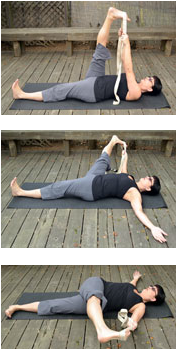 Supta Padangusthasana (Reclining Big Toe Pose) Lie on the back with the legs straight. Variation I: Draw your right knee into your chest and lengthen the left leg onto the floor. Wrap a strap around the ball of your right foot and extend the leg into the air. Reach the hands up the strap until the elbows are straight but the shoulders are still grounded. Variation II: Hold the strap in the right hand and place a block on the outside of the right hip. Externally rotate your leg and as you exhale, lower the leg directly out to the side so that the outer thigh rests on the block. Extend the foot into the strap and reach the left arm out to the side keeping the left hip on the floor. To release, use the inner thigh to draw the leg up to center. Variation III: Hold the strap in the left hand and slowly bring the leg across the body as you twist the lower body, keeping the shoulders on the floor and the right arm out to the side. To release, drop the right hip into the floor and allow the leg to follow. Hold each variation for 10-20 breaths. 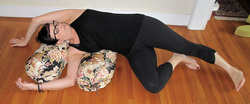 Supported Sidebend Lie on the side with a bolster or rolled blanket under side ribs and a second bolster to support the head Extend bottom arm between the two bolsters. Begin with both knees bent then try extending top leg in line with the rest of the spine. Raise the top arm overhead and support with the head bolster. Breathe into the rib cage that faces the ceiling. Rest 3-5 minutes per side. Therapeutics: Opens both sides of thoracic region increasing breath capacity 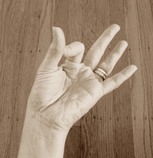 Medha Prana Kriya Mudra Touch index finger nails to the middle joint of the thumb and apply light pressure, extend all other fingers and turn palms up. Benefits: Opens heart and releases deep emotional blockages, encourages breath in the side ribs Practice Tips: Use when feeling bogged down by old emotional patterns 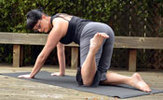 Wagging the Tail Begin on all fours. Inhale: lift left foot by bending the knee. Exhale move left shoulder and hip together as you swing left foot to the left. Inhale to center. Exhale move right shoulder and hip together as you cross left foot over the right shin. Inhale to center. Repeat 5-10 times each side. 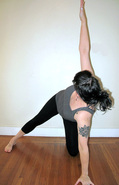 Half Circle Pose Begin kneeling. Straighten right leg out to side and bring left hand to floor in front of the left knee. Inhale right arm up as you twist the torso to the right, hold for 5 breaths. Repeat to the left side. 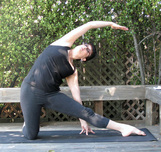 Parighasana (Gate Pose) Begin kneeling. Straighten left leg and press toes towards floor to prevent hyperextension of knee. Exhale and side bend over left leg bringing left hand to block behind knee or to floor. Reach right arm overhead and keep tail bone long. Hold 5-10 breaths then release and change sides. 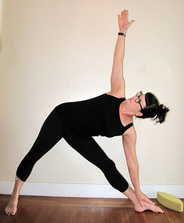 Trikonasana (Triangle Pose) Stand with feet wide apart. Turn left out to 90 degrees and right foot in 30 degrees. Inhale arms out from shoulders. Exhale and cock hips to the left. Reach left arm parallel to floor to lengthen the left waist and bring left hand on block, foot or floor. Rotate the chest towards the right and reach right arm towards ceiling. Hold 5-10 breaths then release and change sides. Therapeutics: Opens side body, strengthens legs, eases pain in the lower back 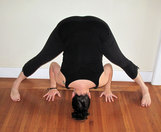 Prasarita Padottanasana (Wide-Legged Forward Bend) Stand with feet wide apart. Bend forward from hips placing hands between feet. Release spine forward with crown of head facing floor. Hold up to 1 minute, then return to standing by drawing hands onto hips and lifting entire torso up as a single unit. Therapeutics: Intense hamstring stretch, opens back of body 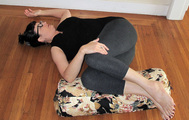 Reclining Twist Lie on back with knees bent and feet on floor. Shift hips to the left a few inches from center. Draw the knees into the chest and release legs to the bolster on the right. You may use right hand to hold down outside of left knee. Reach left arm back to floor and turn head to the center or to the right. Hold for 1-3 minutes, then bend knees and draw them up to center, change sides. Therapeutics: Broadens back of pelvis, stretches outside of legs, gently compresses the abdominal organs 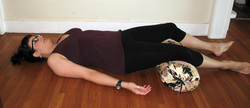 Savasana (Corpse Pose) Lie on back with legs straight and feet relaxed to sides. Move arms away from sides slightly and turn palms to face ceiling. You may use support under the knees for low back pain; and a folded blanket under the head if needed. Rest 5-15 minutes. Therapeutics: Allows for integration of mind and body after asana practice, promotes restful awareness
0 Comments
7/4/2014 The Subtle HeartThe heart chakra, or Anahata, is often mentioned in yoga and we are often asked to open the heart, but what does this actually mean and how can we go about it? The heart chakra is the fourth chakra in the seven chakra system. Is is a mid-point and cross-roads that integrates the worldly experiences of the lower chakras with the more rarefied spiritual experiences of the higher chakras. We can use self-acceptance, love and compassion to release any feelings of doubt or defectiveness that we may have accumulated from old emotional and relationship patterns from our past. Through this integration we are able to open ourselves up to both joy and sorrow so that we are not closed off from any emotion within the heart's realm of experience. The word Anahata translates as "un-struck" which refers to a musical instrument that plays subtle beautiful notes without being touched and to a heart that is un-afflicted by resentment or sorrow. Imagine what it would be like to live as if you had never known disappointment, rejection or hurt? This week it is our goal to bring this openness into our experience through gentle movement which creates physical space in the chest and shoulders; to bring conscious breathing into this area to help to clear stagnant energy which will ultimately help to release old emotional burdens. 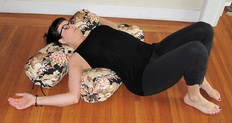 Supported Heart Opener Set up two bolsters perpendicular to mat with folded blanket on the one toward the back of the mat. Sit on folded blanket or on floor facing away from bolsters. Lie back so that shoulder blades and upper back are supported by shorted bolster and the head and neck are supported by the taller bolster. The upper line of the shoulders and arms should fall in between the bolsters. If the elbows to not readily reach the floor, support with more folded blankets. Either straighten legs out to floor or rest knees over bolster. Therapeutics: Opens heart and releases tension across chest, shoulders and neck 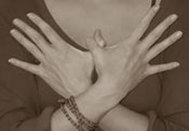 Garuda Mudra Cross the left wrist in front of the right and interlace the thumbs together, splay the other fingers over the upper chest. Benefits: Balances the right and left sides of the body, creates a sense of freedom Practice Tips: Use when you feel stuck in your life or emotions Contraindications: High blood pressure use caution and monitor 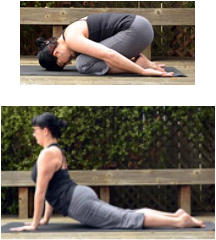 Balasana to Bhujangasana (Child's Pose to Cobra Pose) Begin in Balasana with the arms overhead on the floor. Inhale keep hands where they are and move torso through arms to come into a backbend with pelvis pressing towards floor. Exhale return to Balasana. Repeat 5-10 times with the breath. Therapeutics: Alternately stretches and strengthens front and back of body. 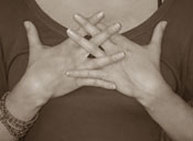 Vajrapradama Mudra Clasp fingers and open palms toward heart; point thumbs upwards. Hold a few inches away from the chest. Benefits: Builds confidence, security, opens the heart very gently Practice Tips: Use when frightened or anxious 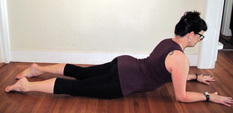 Sphinx Lay on belly with legs together and toes pointed back. Bring forearms to floor with elbows aligned under shoulders and forearms parallel to each other, palms facing down. Lift sternum forward and up through crown of head. If lower back feels vulnerable, engage belly away from floor. Hold 5-10 breaths and release chest to floor with hands under forehead. Therapeutics: Stretches front of body, creates space between vertebrae 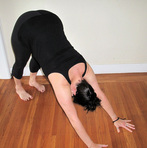 Adho Mukha Svanasana (Downward Facing Dog) Begin on all fours with hands slightly forward of shoulders. Turn toes under and lift knees off floor. Keep shoulders wide and palms flat, press thighs and sit bones back, scooping belly in. Hold 1-3 minutes, release into Child's Pose. Therapeutics: Strengthens arms and shoulders, stretches back of torso and legs 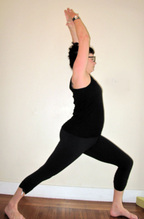 Virabhadrasana I (Warrior I) Begin standing in Tadasana. Step left leg back about three feet keeping feet hips width apart. Keep right toes turned forward and left foot turned slightly out. Turn hips gently towards front foot and balance weight on both feet. Inhale arms overhead. Exhale and bend right knee. Draw belly up and release tail bone towards floor. Hold 5-10 breaths then release and change sides. Therapeutics: Opens front body and psoas, strengthens legs, improves balance  Supta Balasana (Supported Child's Pose) Kneel straddling a long bolster. Place a second bolster over first with end of bolster in front of your low abdomen. A third bolster can go under the far end of the second bolster or use a folded blanket or block to support under it. Extend front of body over second bolster and rest forehead on backs of hands. Rest up to 5 minutes. Therapeutics: Creates a calm, grounded space to get away from the demands of daily life |
Index:Archives:
September 2022
I attend Cheryl's class regularly and feel that my practice has improved immensely over the past few years due to her expert coaching. Her teaching style is clear and compassionate and her previous experience in teaching adults is evident in her organized approach and easy to understand instructions. I also appreciate that Cheryl not only teaches us about how to correctly position ourselves, but also touches on many aspects of yoga philosophy, which in turn has deepened my personal practice and heightened my awareness of the connection between mind and body, breath and relaxation. |

 RSS Feed
RSS Feed
